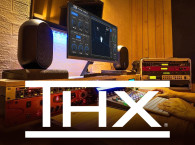The webinar will take place November 23, 2020 at 08:00 AM PST / 11:00 AM EST and will be presented by Elia Shenberger, Director of Business Development at CEVA and Ramani Duraiswami, CEO and Founder, VisiSonics. Register Here Now.
3D audio is suddenly a hot topic. Apple recently released a firmware update to AirPods Pro that enables what Apple calls spatial audio. Think of surround sound, the virtual audio reality experience of listening to a band or an orchestra in which you can hear instruments and singers to the left, right, front and back as if you were in the audience. 3D audio adds audio from above and below and all directions, so users can hear a helicopter coming from behind and flying overhead. All emulated through wireless earbuds, no need to be surrounded by speakers. Second, motion sensors track the head's movements. As the user turns his head, or looks up or down, or leans forward, what he hears is adjusted correspondingly. Neither the user nor the sound source have to be fixed. True virtual audio reality available to all Apple AirPods Pro users. But CEVA and VisiSonics got together to offer 3D audio to everyone, whether they’re using an Android platform, a head-mounted display, AR glasses, anything.
The Apple solution runs on the device that is playing the media - a Mac, iPad or iPhone. IMU based head tracking data is read from the AirPods Pro earbuds to get head pose and movement, but the processing is done on the connected device. This makes for easier software updates but can introduce undesirable latency compared to a system in which 3D processing is handled directly in each earbud.
CEVA has partnered with VisiSonics, a company that develops embedded software and currently offers it RealSpace-3D solution, with support for higher order Ambisonics, object-based audio, channel-based surround sound (5.1 and 7.1), and simple stereo - covering all the bases. That’s important because content producers are likely to use different methods for different purposes. The software can be personalized to an individual user for maximum effect, by calibrating a head-related transfer function (HRTF) taking into account different body sizes and ear shapes. Optimizing this transfer function sharpens the position of the listener in the audio space.
 The VisiSonics RealSpace-3D software can run on CEVA-X2, CEVA-BX1, and CEVA-BX2 audio DSPs, taking motion data from our MotionEngine solution (software and/or hardware as preferred), all running together in an integrated system, which can sit in an earbud, connecting over Bluetooth to your device. All that functionality running directly in each earbud with no latency.
The VisiSonics RealSpace-3D software can run on CEVA-X2, CEVA-BX1, and CEVA-BX2 audio DSPs, taking motion data from our MotionEngine solution (software and/or hardware as preferred), all running together in an integrated system, which can sit in an earbud, connecting over Bluetooth to your device. All that functionality running directly in each earbud with no latency. Join CEVA and VisiSonics experts to learn about:
- Multichannel Audio and Ambisonics
- 3D Audio Applications and Markets
- HRTF and Head-tracking for 3D Audio
Register here for this free session!





